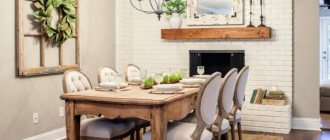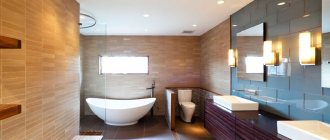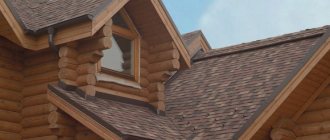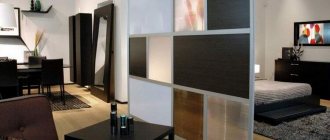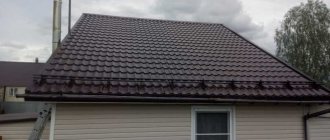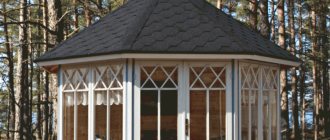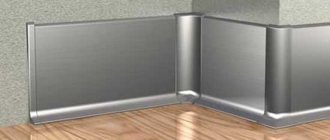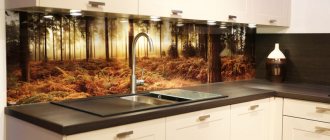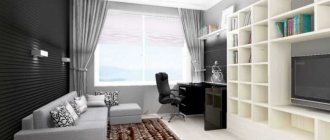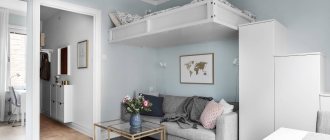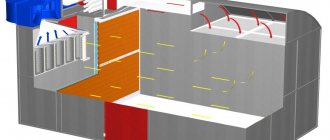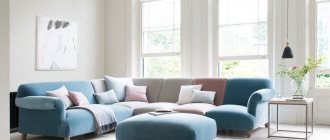Asbestos cement slate
Asbestos-cement slate is a practical, reliable and affordable building material made from cement components, and for additional strength, manufacturers have equipped it with asbestos fibers. Slate consists of 15% asbestos and 85% Portland cement.
Options:
- operational life - 25 years;
- dimensions - 1.2x0.7 m;
- weight - 9.5-16 kg/sq. m.
Pros:
- relative strength;
- ease of installation;
- combustion resistance;
- cheapness.
Minuses:
- with strong impacts the material may crack;
- heavy weight;
- moisture absorption.
The average price in Russia ranges from 120 to 240 rubles per 1 sq. m. m. For example, if you want to cover a roof with an area of 100 square meters. m., then it will cost 24,000 rubles excluding the cost of fasteners.
Using special paints, asbestos cement slate can be painted in a preferred color that would blend well with the house. The palette is rich, so there is plenty to choose from.
Metal tiles are durable, but not always economical
The appearance of the colored metal profile resembles natural tiles. The roof looks attractive for a long time. The material is cut to customer sizes, which minimizes waste.
Advantages of metal tiles
- wide temperature range of application;
- lightweight roofing pie;
- large selection of colors;
- high-quality waterproofing.
Cons of metal tiles
- expensive soundproofing “pillow”;
- high cost of additional elements;
- the likelihood of corrosion;
- complex installation.
The cost of metal tiles depends on the initial thickness of the metal and the type of polymer coating. The average price per square meter is about 260-300 rubles . But the cheaper the roofing, the shorter its service life.
Reviews about metal tiles
Euroslate
Euroslate refers to ondulin or ethernit. The materials are externally identical, differing only in composition, size and weight. Eternite is made in segments measuring 70-80 cm and consists of asbestos cement and polymer fibers. The building material is foreign and costs a little more than classic ondulin.
Ondulin is made from polymers, and its structure is formed by ultra-thin cellulose fibers treated with special additives and bitumen. This roofing building material is covered in several layers of a protective polymer solution.
Options:
- waves 3.6 cm high;
- dimensions - 2x0.96 m;
- weight - 6.5 kg/sq. m.
Pros:
- moisture resistance;
- environmental friendliness;
- long service life;
- a light weight.
Minuses:
- fragility;
- burns at a temperature of 110 degrees Celsius;
- The paint layer fades quickly.
If the roof is damaged and elements need to be replaced, then it is not so easy to walk on it, since the building material can crack under the weight of a person. You will have to make special stairs. However, the great advantage of Euro slate roofing is its noiselessness. During heavy rain, you will not hear the sounds of drops crashing on the roof. The average price of such coverage is 170-200 rubles per 1 sq. m. m.
Metal tiles
This is perhaps one of the best options, which successfully combines relatively low cost and high quality. The production of metal tiles is based on the latest developments. With the help of modern advances in chemistry, it was possible to create a unique coating for steel. Now the metal is reliably protected from corrosion. It should be noted that this unique coating is used not only in the manufacture of metal tiles, but also other roofing materials. Corrosion protection is required for all types of metal roofing.
Of course, the process of manufacturing metal tiles is quite complicated. First, the steel is primed, then the bottom side of the product is coated with a protective varnish, and the top side is coated with a polymer coating, thanks to which the metal is not subject to corrosion. Roofing materials treated in this way will reliably protect the house from precipitation in the form of rain, snow or hail.
Structure of metal tiles.
There are several types of metal tiles. Differences arise due to different polymer coatings. The most budget option is polyester. The basis of this protective coating is polyester paint. Polyester comes in matte and glossy. This makes it possible to select the right material that matches the overall architectural design. Polyester can withstand heat and cold, but it is highly sensitive to mechanical action. That is why transportation and installation of polyester-coated metal tiles requires special care.
A slightly more expensive option is pural protective coating. Roofing materials treated with it are able to withstand large temperature changes. In general, pural is more durable than polyester. However, plastisol is considered the highest quality polymer coating. It reliably protects steel not only from corrosion and large temperature changes, but also from rough mechanical actions. Roofing materials coated with plastisol are easy to install and are suitable for roofs with different slopes.
The advantages of metal tiles include light weight, ease of installation, durability, and fire resistance. The main disadvantage is poor sound insulation. Steel roofing materials do not protect residents from noise from the street. However, this problem can easily be eliminated by taking additional noise insulation measures.
Rolled bitumen roofs
This is the cheapest roofing option - you can cover the roof with such material at minimal cost. Roofing felt is produced in the form of rolls. Durable cardboard is used as a basis and bitumen is applied on both sides. The front side of the coating is sprinkled with crumbs.
There are different types of rolled bitumen building materials at different prices. The most expensive is Aquaizol - this roofing is thick and viscous. Install aquaizol by fusing. And the cheapest options are good for a couple of seasons, then the coating will have to be changed.
Options:
- thickness - 1-4 mm;
- length - 10-20 m;
- width - 1 m;
- weight - 1-4 kg/sq. m.
Pros:
- cheapness;
- ease of installation - can be nailed or fused;
- ease.
Minuses:
- bitumen roofing is highly flammable;
- At extreme temperatures it melts.
Fusing bitumen roll roofing in 2 layers will provide good waterproofing. However, it will take two people to install such material. The price of roofing felt is 30-100 rubles per 1 sq. m. m.
Slate - cheap and cheerful
Asbestos-cement slate is still very popular. Manufacturers offer several sizes and color options, but the most commonly found on the market is an 8-wave gray sheet.
Pros of slate
- fire resistance (cracks, but does not burn);
- versatility - suitable for any climate;
- mechanical and biological stability;
- maintainability (damaged sheets can be replaced);
- simple and straightforward installation.
Disadvantages of slate
- contains asbestos;
- weighs a lot;
- often covered with moss;
- breaks easily during transportation;
- not suitable for roofs with complex shapes.
The price per square meter of gray slate varies between 120-140 rubles , colored slate is more expensive.
Reviews about slate
Flexible tiles
This is a modernized bitumen roofing that is produced in the form of tiles. The material consists of fiberglass treated with bitumen, polymers, basalt or slate chips, which decorate and protect the tiles from exposure to ultraviolet rays. Soft roofing is designed to cover complex roofs with slopes and transitions.
Options:
- sizes - 10-30 cm;
- there are types with rectangular and rounded edges;
- weight - 8-12 kg/sq. m.
Pros:
- good sound insulation;
- aesthetics;
- plastic;
- condensation and corrosion do not form;
- long service life.
Minuses:
- labor-intensive installation;
- flammability of the material;
- In severe frosts, bitumen cracks.
If installed correctly, soft tiles will last for several decades, since the bitumen itself is durable. The average price of such a roof is 220-260 rubles per 1 sq. m. m.
Ondulin and Onduvilla - environmentally friendly bitumen materials
Bitumen roofing is an excellent option for self-installation. Installing Ondulin and Onduvilla does not require professional skills. The manufacturer's instructions are sufficient.
Pros of Ondulin
- resistance to sun, frost, precipitation and mechanical stress;
- low sheet weight;
- good sound insulation in the rain (no ringing);
- harmless to humans;
- resistance to mold and mildew;
- good price;
- roofing warranty from the manufacturer.
Cons of Ondulin
- color stabilization after installation (about 6 months);
- flammability limit - 110 degrees;
The price per square meter of Ondulin depends on the color of the sheet and the region of sale, the cost is from 254 rubles .
You can check current prices and find out about promotions on the manufacturer’s official website onduline.ru .
Reviews about Ondulin
Corrugated sheet
This is a roofing material that can be used to inexpensively cover the roof of a house or cottage. Corrugated sheets are mainly made of zinc, but there are types with a polymer protective coating, which increases their service life. The waves on the building material are not round, like on ordinary slate, but rectangular, so joining between sheets is easy.
Options:
- thickness - 0.8-4.4 mm;
- dimensions - 1.15-1.19 m;
- weight - 4-9 kg/sq. m.
Pros:
- cheapness;
- strength;
- ease of installation;
- long service life.
Minuses:
- noisiness;
- Damage to the protective coating may lead to corrosion;
- sheathing required.
Corrugated sheeting is an analogue of metal tiles, only several times cheaper. It is much better than roll roofing. The average cost of such coverage is 150-250 rubles per 1 sq. m. m.
Purpose of coatings and requirements for them
Everyone understands that the roof must reliably protect the house from various weather disasters, be durable and attractive. But there are still a number of requirements that a reliable and high-quality roof must meet. Let's figure out what we're talking about.
During operation, the covering of the roof of the house and the roof itself are subject to various influences, which can be divided into:
- power (wind, hail, snow load);
- not forceful (temperature changes, ultraviolet healing).
And the roof must withstand all these impacts during its operation. From here it becomes clear that the covering for the roof of the house> should be:
- strong and durable;
- sealed and moisture resistant;
- resistant to temperature changes;
- capable of withstanding various external influences without changing the quality of the roofing, without cracks or deformations.
Very often, owners are faced with the question of which coating is best for the roof. It is not possible to give a definite answer, since in each specific situation the coating most appropriate to the roof structure and its purpose should be used. So that you can easily choose the right covering for your roof, let's look at the different types of roofing materials and their characteristics.
Euroroofing felt, roofing felt
Euroruberoid is a popular roofing material. Its advantages:
- a light weight;
- relatively low price;
- works well in all weather conditions;
- easy installation;
- well-laid euroroofing felt retains its waterproof qualities for more than 30 years.
Different types of roofing felt are laid in different ways:
- some types are attached with glue;
- others are liquid;
- still others require heat styling.
It is important that the coating is completely sealed.
Before laying roofing felt, the base should be primed, even if it is old roofing felt. The primer is made with a special asphalt mixture for priming.
Old roofing felt is a good base for a new one. Keep this in mind, because getting rid of the old layer is an expensive, very troublesome undertaking.
Roofing felt should be laid at temperatures above + 50 °C; it is necessary to choose a day without precipitation. The following may have a negative effect on styling:
Although roofing felt is slowly going out of fashion, it has many supporters as the best option for an inexpensive roofing material. Roofing felt roofing material is relatively inexpensive and durable.
Which is better: a review of roofing materials
The range of roofing coverings is wide. They are divided into two large groups: flexible and rigid. The first is made from bitumen, fiberglass, cellulose. The raw materials for the second are cement, composite, metal, etc. Both groups are in demand. Let's consider the best way to cover the roof of a house.
Wave slate
A veteran among rigid roofing materials, it has been produced for decades. For its production, Portland cement is used mixed with asbestos and water. The resulting mass is formed into sheets. Previously, they were not painted, they remained light gray. Modern models are painted in different colors. If the paint is added at the mixing stage, the product will not fade.
pros
- Strength. The wave sheet can easily support the weight of an adult.
- Service life is about 25 years.
- Good heat and sound insulation characteristics.
- Maintainability. If required, you can replace only the damaged element.
- It does not ignite and does not emit toxic substances when exposed to high temperatures.
- The price of sheets is low.
Minuses
First of all, this is the presence of asbestos. Recent studies have shown it to be a carcinogen. Therefore, chrysolite-cement plates are increasingly appearing on sale. They are safe. Another disadvantage of asbestos cement is its hygroscopicity. It absorbs moisture, which leads to gradual cracking and destruction.
Slate plates are not flammable, but in a fire they crack and produce sparks. This could cause fires in nearby houses. Installation is made difficult by the significant mass of sheets, each weighing 20 kg. If handled carelessly, slate can crack; it is quite fragile.
Choosing a roofing supplier
In order to determine a reliable supplier (seller) of roofing materials, we recommend taking into account the following recommendations:
- Study and compare prices for similar products from different suppliers: offers can vary significantly (we are always happy to offer some of the best conditions in Belarus - from only 8.87 rubles/m²).
- It is better to choose a seller who is capable and ready to offer you a full range of services: from taking measurements, complete supply of roofing and related materials to installation of the roof.
- Check the availability of direct deliveries from manufacturers (the more intermediaries, the higher the cost; we work only directly).
- Analyze the assortment of the product line, which should include popular manufacturers (the choice is easier to make when there is plenty to choose from).
- Personally verify the quality of the product and ensure that it meets your expectations (visit a conveniently located office in Minsk in a showroom format, where you can see and touch all types of roofing and related materials yourself and receive qualified advice, at the address: Minsk, Yanka St. Mavra, 41, office 401).
- Make a turnkey purchase (purchase of a roof and hiring a professional roofing crew for its subsequent installation in one place - the most advantageous comprehensive offer).
- Choose the most convenient payment options for roofing materials (including installments for roofing at 0% for up to 36 months).
Simple bitumen roll coatings
These include various types of roofing felt, the basis of which is cardboard, metalloizol, folgoizol and others. Such coatings are used for hydro- and vapor barrier installations. Roofing and lining roofing material is used to cover pitched and flat roofs. One of the significant disadvantages of such coatings is their short service life - no more than five years. Rolled materials are highly sensitive to atmospheric conditions. They do not tolerate temperature changes, UV rays and precipitation well. Many people try to save money and purchase such coatings. However, subsequently such initial cheapness will result in significant financial costs. Those materials that contain a foil layer are of higher quality: metalloizol and folgoizol.
Coating composition
In accordance with this indicator, the roofing material can be:
- Mineral.
- Metallic.
- Organic.
A large assortment of materials of the latter category is presented on the market today. In earlier times, the most popular organic coverings were shingles and straw. Modern roofing materials of this type can last from 5-7 to 25-30 years. These, in particular, include bitumen-polymer, polymer and bitumen coatings. The disadvantage of these coatings is their instability to oxygen and UV rays. Under the influence of these factors, materials wear out quite quickly, and some may rot. All organic coatings are flammable. The range of mineral (also called “stone”) materials is slightly smaller. Until recently, slate tiles and ceramic tiles were common in this category. Today, more modern coatings have appeared. In particular, these are asbestos-cement sheets (slate) and cement-sand tiles. These materials are more durable than organic ones. Mineral coatings are resistant to UV rays and are less susceptible to rotting. However, they do not tolerate temperature changes quite well. Metal coatings include sheet materials. Copper, zinc, and steel are used as raw materials. Galvanizing, in comparison with other coatings in this category, is not as durable. Its service life is no more than 50 years. But copper and zinc coatings can last up to 100 years.
Choosing a team to install the roof
If you are not confident in your knowledge, skills and experience, it is better to entrust the construction of the roof to professional craftsmen. Saving on work is not at all worth the peace of mind during subsequent living in a warm and reliable home. You should be confused if potential performers:
- ready to start work after a superficial acquaintance with the photo or a brief explanation from the customer;
- cannot confirm their experience and competence with previously implemented projects, reviews and other means;
- they call “blurred” deadlines for completing work;
- are not ready to document the guarantee for the work performed;
- not aware of new collections and new roofing materials.
Choose trusted roofing installers so that considerable amounts of money spent on purchasing expensive roofing materials do not go to waste. Our installation team of roofers is equipped with modern equipment and tools. Craftsmen are constantly trained in new techniques and working with new roofing materials. Ready to take on the most complex projects. We stand out among competitors with high-quality individual customer service, guaranteed results, and prompt completion of work without compromising quality.
“ GoodRoofing ” is a reliable Belarusian company with a long history, in which every client who contacts will be helped to choose the roof of their dreams. We try to fully comply with the slogan “ A good roof for every home!” "and do your job better than others. We will be glad to receive your questions, orders and profitable purchases on the website.
Variety of roofing materials
Tiled roofing types
Ceramic tiles without additional fixation can be used for roofs with a slope of 22-60 degrees.
Shingles are among the oldest roofing materials. Houses in the old quarters of Europe are covered with this particular type of roofing with variegated colors. Previously, only ceramic tiles were made, but now the range of materials is much wider.
These pieces are pieced (the size of one plate is 30 by 30 cm), fired in a kiln and acquired a brownish-red tint. Glazed tiles look more attractive and are more convenient to use: neither snow nor rain moisture will remain on them. The weight of one piece after firing is over 2 kg.
The shape of the elements can be different: wavy, tape, grooved, grooved, etc. And at the same time, the mounting options will be different. But the properties of all products are similar to each other. When laying, try to lay the tiles so that the plate on top covers one third of the bottom.
The use of tiles is advisable for buildings of any number of storeys with a roof slope in the range of 22-60 degrees. With a greater slope, additional mechanical fixation of each tile is provided using a screw or nail. With a slight slope, a high level of roof ventilation and waterproofing is provided.
Advantages: the coating is reliable, durable, non-flammable, frost-resistant over 1000 cycles, does not corrode, has good noise insulation, easy to repair (only damaged areas are replaced, without dismantling the entire roof). The disadvantages include the heaviness and fragility of the material, the need for waterproofing, the use of additional fasteners and reinforcement of the sheathing for complex roof configurations.
How to re-roof a private house cheaply?
What is cheaper to cover the roof of a house - with metal tiles or corrugated sheets, flexible tiles or metal tiles? The most popular materials are tiles, roofing sheets or roofing felt. They differ in installation method, quality, and prices. Some of the benefits of these materials may be key to your choice.
Popular inexpensive roofing materials are as follows:
- metal tiles or sheet metal, corrugated sheets (galvanized steel, copper);
- roofing felt (used for flat roofs and surfaces with a slight slope);
- cement tiles;
- roofing bitumen of various forms.
Let's take a closer look at them.
Advanced Coatings
When arranging the upper and lower roofing layers, as well as when laying waterproofing, roll materials based on fiberglass, polyester or fiberglass are used. Among them, for example, it is worth noting rubestek, bikrost, linokrom, rubemast, steklobit. As a rule, they are used on flat and pitched structures (with a slope of up to 25%). If the slope is greater, then at high temperatures the material may slide off the roof. Mastic is used to fix the coatings. Another disadvantage is the need for multi-layer installation using gravel and stone chips. In general, the service life of the coating is about 15 years.
